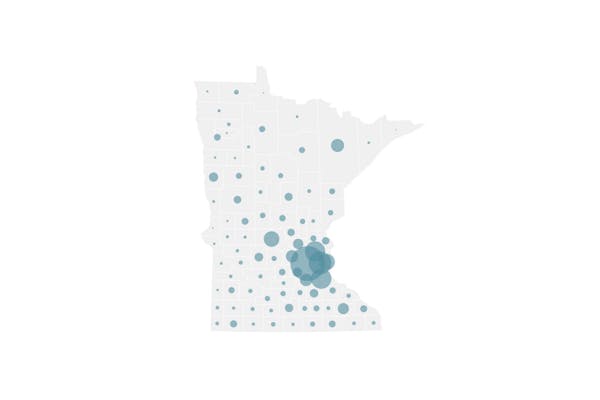Minnesota added 481 new confirmed cases of COVID-19 and 20 more deaths to its statewide tally Sunday, as state testing for the virus continues to ramp toward maximum capacity.
The state has had 11,271 cases of the disease confirmed by laboratory testing, and 6,882 people who have been released from self-quarantine since the first case was diagnosed in Minnesota on March 6.
As of Sunday, 578 deaths have been officially linked to COVID-19 in the state. The 20 additional deaths included 16 people who lived in long-term care, assisted living or residential behavioral health settings. The ages of the 20 people who died ranged from 50 to 89 years old.
Those statistics are closely watched because group-living arrangements and advanced age increase the risks of contracting a serious case of COVID-19. Another factor that increases the risk is having underlying health conditions, from lung disease, serious heart conditions and cancer to severe obesity, diabetes and kidney patients who require dialysis.
About 80% of people infected with the novel coronavirus have mild symptoms, while as many as 5% require critical care in a hospital. The latest statistics in Minnesota show 434 people currently hospitalized, including 199 people in intensive care unit (ICU) beds.
In Minnesota, about 34% of the 1,687 people with confirmed hospitalizations for COVID-19 since March 19 were treated in ICU, the state's daily update said.
The pace of new infections, as well as the rate of people being released from quarantine, is rising as the state increases the number of molecular tests conducted to diagnose the disease.
On Sunday, the state reported the results of 4,593 tests that were completed in the 24-hour period between 4 p.m. Friday and 4 p.m. Saturday. It was the fifth consecutive day of more than 3,500 test results being reported.
Gov. Tim Walz has announced plans to develop a capacity to test 20,000 patient specimens per day in the state, as a first step toward reopening more businesses and public facilities.
But the state is far from reaching that goal.
State officials late last week were urging people who have symptoms of COVID-19 to contact their health care providers and get tested. Although the state has increased its testing capacity, state Health Commissioner Jan Malcolm said health care providers are reporting that not enough people are asking for tests, perhaps because of widespread reports early in the outbreak that testing capacity was strained.
Another factor Walz has said is key to deciding when to reopen businesses and public facilities is the availability of medicine to treat COVID-19.
On Saturday night, state health officials announced guidelines for how to ethically manage what the Minnesota Medical Association described as "a larger than expected initial supply" of an investigational drug for COVID-19 called remdesivir that is being provided to the state.
Use of intravenous remdesivir, made by California-based Gilead Sciences, was associated with faster time to clinical improvement than a placebo in 237 symptomatic Chinese patients who took part in a randomized clinical trial, according to a report about the study in The Lancet.
But the double-blinded trial did not lead to a ringing endorsement for wider use of remdesivir: "Among patients who were treated within 10 days of symptom onset, remdesivir was not a significant factor but was associated with a numerical reduction of 5 days in median time to clinical improvement," the report concluded.
The Food and Drug Administration granted the unapproved drug an emergency-use authorization (EUA) to be used in the United States, noting that it was "reasonable to believe that the known and potential benefits of (remdesivir) outweigh the known and potential risks of the drug for the treatment of patients hospitalized with severe COVID-19."
In the clinical trial, adverse events were reported in 66% of the remdesivir patients, and 64% of the placebo patients. Eighteen people in the study were taken off the drug early, as were four of the placebo patients who were not told whether they got the real drug or not.
Minnesota's guidance on distributing the scarce drug says it should be allocated assuming the patient needs a 10-day course, as per the EUA. But patients who are not using a mechanical ventilator or a heart-lung bypass machine called an ECMO should be evaluated for stopping the drug after five days, so that extra doses can be reallocated to other patients.
"Distribution of [remdesivir] to health care facilities across the state should be proportional to the total number of COVID-positive patients currently admitted to the facility," the guidelines say. "In other words, more resources should be sent to facilities with greater numbers of prioritized recipients, so that patients at highest priority have maximal access to the scarce resources."
The highest-priority patients include those with confirmed cases of COVID-19 who have been on a ventilator for five days or less, or are using an ECMO or an advanced respiratory support system. Decisions on who gets the drug should include the patient's chances of surviving COVID-19, and whether they're terminally ill from another condition with life expectancy of less than six months.
Joe Carlson • 612-673-4779

Minneapolis reaches $150k settlement with eyewitness of George Floyd's murder

Israel-Hamas war creates 'really fraught times' at Minn. colleges

Rare and fatal brain disease in two deer hunters heightens concerns about CWD

